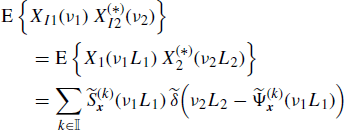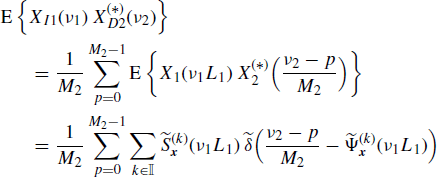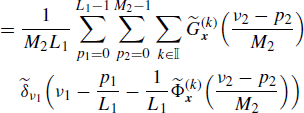4.10 Multirate Processing of Discrete-Time Jointly SC Processes
In multirate digital signal processing, systems constituted by complicate interconnections of interpolators, decimators, and linear time-invariant (LTI) filters acts on input stochastic processes (Crochiere and Rabiner 1981), (Vaidyanathan 1990). Since interpolators and decimators are linear time-variant systems, the stationarity or nonstationarity properties of the input processes turn out to be modified at the output. For example, the expanded version of a WSS process is cyclostationary with period of cyclostationarity equal to the expansion factor (Sathe and Vaidyanathan 1993).
The effects of multirate systems on second-order WSS and cyclostationary processes are analyzed in (Sathe and Vaidyanathan 1993). In (Akkarakaran and Vaidyanathan 2000), conditions that preserve at the output of an interpolation filter the wide-sense stationarity of the input sequence are derived. Moreover, conditions for the joint wide-sense stationarity of the outputs of interpolation filters are also obtained. Higher-order statistics of ACS processes are considered in (Izzo and Napolitano 1998b).
In (Sathe and Vaidyanathan 1993), (Izzo and Napolitano 1998b), and (Akkarakaran and Vaidyanathan 2000), multirate operations on a single process are addressed and no cross-statistics of a process and its expanded or decimated version are considered. Moreover, no cross-statistics are considered between processes obtained by multirate elaborations of the same process with different rates.
Expansions with different rates transforms jointly WSS, jointly ACS, and jointly SC processes into jointly SC processes. An analogous result is obtained by decimation with different rates.
In this section, the effects of expansion and decimation operations on jointly SC processes are analyzed. Specifically, the way in which the Loève bifrequency cross-spectrum of input jointly SC processes transforms into the Loève bifrequency cross-spectrum of the output processes is derived for expansors and decimators which are the basic building blocks of multirate systems. The class of the jointly SC processes is shown to be closed under linear time variant transformations realized by interconnecting expansors and decimators. The case of input jointly ACS processes is analyzed in detail. It is proved that even if the input processes are jointly ACS, in general the output processes are jointly SC. Known results for ACS processes are obtained as special cases.
The problem of suppressing imaging and aliasing replicas in the Loève bifrequency cross-spectra of interpolated or decimated processes is addressed. Specifically, the reconstruction (but for two frequency scale factors) of an image-free Loève bifrequency cross-spectrum of two jointly SC processes when they passes through two interpolator filters is considered. Then, the reconstruction of a frequency-scaled version of the Loève bifrequency cross-spectrum of two jointly SC processes starting from the outputs of two decimation filters is addressed. Finally, the problem of reconstructing a frequency-scaled image-and alias-free version of the Loève bifrequency cross-spectrum of two jointly SC processes starting from their fractionally sampled versions is treated.
4.10.1 Expansion
4.10.1.1 LTV System Characterization
The L-fold expanded version of the discrete-time signal x(n) is defined as
(4.237) 
Thus, it results that
(4.238) ![]()
from which it follows that the Fourier transform XI(ν) of xI(n) is given by
In Section 5.11 it is shown that expansion is a linear time-variant transformation (Figure 4.16)
(4.240) ![]()
with impulse-response function
and transmission function
(4.242a) ![]()
where
and the subscript in notation ![]() and
and ![]() indicates the variable with respect to which periodization is made and needs to avoid ambiguities when a function of two variables λ and ν is considered.
indicates the variable with respect to which periodization is made and needs to avoid ambiguities when a function of two variables λ and ν is considered.
Figure 4.16 L-fold expansion
The function HI(ν, λ) is periodic in ν with period 1/L and periodic in λ with period 1. Systems performing L-fold expansion are a special case of discrete-time FOT-deterministic LTV systems (Section 4.3.1) not LAPTV.
4.10.1.2 Input/Output Statistics
Let xIi(n) be the Li-fold expanded version of xi(n), (i = 1, 2). That is
whose Fourier transform is
If x1(n) and x2(n) are jointly SC with Loève bifrequency cross-spectrum (4.190a), the Loève bifrequency cross-spectrum of the expanded processes xI1(n) and xI2(n) (Figure 4.17) is given by
where, in the third equality, the scaling property of the Dirac delta is used (Zemanian 1987, Section 1.7) and in the fourth equality (5.191) is accounted for. Equivalently, accounting for (4.190b), we also have
(4.247b) 
From (4.246a)–(4.246c) and (4.247a)–(4.247c) it follows that the expanded processes are jointly SC. In addition, their Loève bifrequency cross-spectrum is periodic in ν1 with period 1/L1 and in ν2 with period 1/L2.
Figure 4.17 Expansion of two processes with different expansion factors
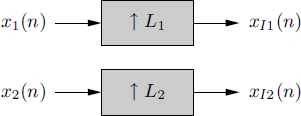
In the special case of x1(n) and x2(n) jointly ACS, accounting for (4.202), the Loève bifrequency cross-spectrum of the expanded processes xI1(n) and xI2(n) can be expressed as
(4.248b) 
In (4.248a)–(4.248c), the cyclic spectra ![]() are periodic in ν1 with period 1/L1 and the delta train is periodic in ν1 with period 1/L1 and is periodic in ν2 with period 1/L2. Therefore,
are periodic in ν1 with period 1/L1 and the delta train is periodic in ν1 with period 1/L1 and is periodic in ν2 with period 1/L2. Therefore, ![]() is periodic in ν1 with period 1/L1 and in ν2 with period 1/L2. In addition, from (4.248c) it follows that the Loève bifrequency cross-spectrum of the expanded processes xI1(n) and xI2(n) in the principal domain (ν1, ν2)
is periodic in ν1 with period 1/L1 and in ν2 with period 1/L2. In addition, from (4.248c) it follows that the Loève bifrequency cross-spectrum of the expanded processes xI1(n) and xI2(n) in the principal domain (ν1, ν2) ![]() [− 1/2, 1/2)2 has support curves (for the case (−) present)
[− 1/2, 1/2)2 has support curves (for the case (−) present)
(4.249) ![]()
that is, lines with slope L1/L2. Consequently, xI1(n) and xI2(n) are jointly SC. In particular, for a single process x1(n) ≡ x2(n) ≡ x(n), by taking L1 = 1, that is xI1(n) ≡ x(n), it follows that the ACS process x(n) and its expanded version xI2(n) are jointly SC with support lines with slope 1/L2. In the special case of x(n) WSS, x(n) and xI2(n) are jointly SC with support constituted by a unique line.
In Section 5.11 it is shown that when x1(n) and x2(n) are jointly ACS the cross-correlation function of xI1(n) and xI2(n) is given by
where the Kronecker delta ![]() is defined in (5.190) and
is defined in (5.190) and ![]() is defined according to (4.244), that is,
is defined according to (4.244), that is,
(4.251) 
When L1 ≠ L2, the argument of the cyclic cross-correlation function ![]() contains the time variable n. Consequently, under the mild assumption that
contains the time variable n. Consequently, under the mild assumption that ![]() , it follows that, for every fixed m, the cross-correlation function in (4.250) as a function of n does not contain any finite-strength additive sinewave component. That is, xI1(n) and
, it follows that, for every fixed m, the cross-correlation function in (4.250) as a function of n does not contain any finite-strength additive sinewave component. That is, xI1(n) and ![]() do not exhibit joint almost-cyclostationarity at any cycle frequency:
do not exhibit joint almost-cyclostationarity at any cycle frequency:
(4.252) 
In particular, their time-averaged cross-correlation ![]() is identically zero. Moreover, from (4.250) it follows that xI1(n) and xI2(n) are jointly ACS if and only if L1 = L2 = L. In such a case, their cyclic cross-correlation functions are (Section 5.11)
is identically zero. Moreover, from (4.250) it follows that xI1(n) and xI2(n) are jointly ACS if and only if L1 = L2 = L. In such a case, their cyclic cross-correlation functions are (Section 5.11)
Furthermore, since from (4.253) it follows
(4.254) ![]()
accordingly with the Fourier-transform pair (4.244) and (4.245), the cyclic cross-spectra of xI1(n) and xI2(n) are
In the special case of x1 ≡ x2, (4.253) and (4.255) reduce to (Izzo and Napolitano 1998b, eqs. (32) and (34)) specialized to second order.
4.10.2 Sampling
Let xδi(n) be the sampled version of xi(n), with sampling period Mi (i = 1, 2). That is
(4.256) 
Accounting for (5.190), the Fourier transforms of the sampled processes are
where ⊗ denotes periodic convolution with period 1. Consequently, if x1(n) and x2(n) are jointly SC with with Loève bifrequency cross-spectrum (4.190a), then the Loève bifrequency cross-spectrum of xδ1(n) and xδ2(n) is
Equivalently, accounting for (4.190b) we also have
Thus, the sampled processes xδ1(n) and xδ2(n) are jointly SC. In addition, the Loève bifrequency cross-spectrum (4.258) (or (4.259)) is periodic in ν1 with period 1/M1 and in ν2 with period 1/M2.
In the special case where x1(n) and x2(n) are jointly ACS, accounting for (4.402), it results in
(4.260) 
That is, the sampled processes are in turn jointly ACS for every value of M1 and M2. Such a result is not surprising since sampling is a linear periodically time-variant transformation (Napolitano 1995). In addition, if M1 = M2 = M, in Section 5.11 it is shown that the cyclic cross-correlation function of xδ1(n) and xδ2(n) is given by
By Fourier transforming both sides of (4.261) and using (5.190), we have the following expression for the cyclic cross-spectrum
where ⊗ denotes periodic convolution with period 1, and the fact that ![]() is the unit element for the periodic convolution with period 1 is used.
is the unit element for the periodic convolution with period 1 is used.
4.10.3 Decimation
4.10.3.1 LTV System Characterization
The M-fold decimated version xD(n) of the discrete-time signal x(n), its link with the sampled signal xδ(n), and the frequency-domain counterpart of these relationships are
(4.263) ![]()
(4.266) 
where (4.265) is obtained by (4.264) accounting for (4.239).
In Section 5.11 it is shown that decimation is a linear time-variant transformation (Figure 4.18)
(4.267) 
with impulse-response function
and transmission function
(4.269a) ![]()
where ![]() and
and ![]() are defined in (4.243).
are defined in (4.243).
Figure 4.18 M-fold decimation
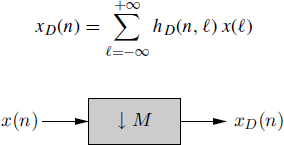
The function HD(ν, λ) is periodic in ν with period 1 and periodic in λ with period 1/M. Systems performing M-fold decimation are a special case of discrete-time FOT-deterministic LTV systems (Section 4.3.1) not LAPTV.
4.10.3.2 Input/Output Statistics
Let xDi(n) be the decimated version of xi(n), with decimation factor Mi (i = 1, 2) (Figure 4.19). That is,
Figure 4.19 Decimation of two processes with different decimation factors

The cross-correlation functions of decimated, sampled, and original signals are linked by the relationship
(4.271) 
Since the sampled process is an expanded version of the decimated process, that is xδi(n) = xDi[n/Mi], accounting for (4.245), the Fourier transform of the sampled and decimated processes are linked by Xδi(ν) = XDi(νMi). Thus, using (4.257), the Fourier transforms of the decimated processes are
Therefore, if x1(n) and x2(n) are jointly SC with Loève bifrequency cross-spectrum (4.190a), by using (4.258) and (4.272), the Loève bifrequency cross-spectrum of xD1(n) and xD2(n) can be expressed as
where, in the third equality, the scaling property of the Dirac delta (Zemanian 1987, Section 1.7) and identity (5.192) are used. Analogously, accounting for (4.259) one obtains the equivalent expressions
(4.274b) 
From (4.273a)–(4.273c) and (4.274a)–(4.274c) it follows that the decimated versions of jointly SC processes are jointly SC. In addition, unlike the case of sampled processes, their Loève bifrequency cross-spectrum is periodic with period 1 in both variables ν1 and ν2.
In the special case where x1(n) and x2(n) are jointly ACS, then accounting for (4.202) it results in
The cyclic spectra ![]() are periodic in ν1 with period M1 and the delta train is periodic in both ν1 and ν2 with period 1. In addition, from (4.275) it follows that the Loève bifrequency cross-spectrum of the decimated processes xD1(n) and xD2(n) in the principal domain (ν1, ν2)
are periodic in ν1 with period M1 and the delta train is periodic in both ν1 and ν2 with period 1. In addition, from (4.275) it follows that the Loève bifrequency cross-spectrum of the decimated processes xD1(n) and xD2(n) in the principal domain (ν1, ν2) ![]() [− 1/2, 1/2)2 has support curves (in the case (−) present)
[− 1/2, 1/2)2 has support curves (in the case (−) present)
(4.276) ![]()
that is, lines with slope M2/M1. Consequently, unlike the case of sampled processes, the decimated processes xD1(n) and xD2(n) are jointly SC. In particular, for a single process x1(n) ≡ x2(n) = x(n), by taking M1 = 1, that is xD1(n) ≡ x(n), it follows that the ACS process x(n) and its decimated version xD2(n) are jointly SC with support lines with slope M2. In the special case of x(n) WSS, the support line is unique.
In Section 5.11 it is shown that, when x1(n) and x2(n) are jointly ACS, the cross-correlation function of xD1(n) and xD2(n) is given by
By reasoning as for (4.250), we have that if ![]() then for M1 ≠ M2 the right-hand side of (4.277), as a function of n, does not contain any finite-strength additive sinewave component. That is, for M1 ≠ M2 the processes xD1(n) and
then for M1 ≠ M2 the right-hand side of (4.277), as a function of n, does not contain any finite-strength additive sinewave component. That is, for M1 ≠ M2 the processes xD1(n) and ![]() do not exhibit joint almost-cyclostationarity at any cycle frequency. From (4.275) and (4.277) it follows that xD1(n) and xD2(n) are jointly ACS if and only if M1 = M2 = M. In such a case, their cyclic cross-correlation function is (Section 5.11)
do not exhibit joint almost-cyclostationarity at any cycle frequency. From (4.275) and (4.277) it follows that xD1(n) and xD2(n) are jointly ACS if and only if M1 = M2 = M. In such a case, their cyclic cross-correlation function is (Section 5.11)
and, accounting for the Fourier-transform pair (4.270) and (4.272), their cyclic cross-spectrum can be expressed as
In the special case x1 ≡ x2, (4.278) and (4.279) reduce to (Izzo and Napolitano 1998b, eqs. (22) and (24)) specialized to second order. In addition, by comparing (4.261) with (4.278) the following relationship between cyclic cross-correlations of decimated and sampled signals can be established
(4.280) ![]()
or, equivalently
(4.281) ![]()
Moreover, by comparing (4.262) with (4.279) it results in
(4.282) ![]()
4.10.4 Expansion and Decimation
Let xI1(n) and xD2(n) be the L1-fold expanded and M2-fold decimated versions of x1(n) and x2(n), respectively (Figure 4.20).
Figure 4.20 Expansion and decimation of two processes
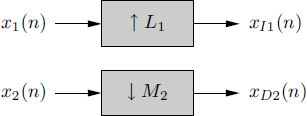
If x1(n) and x2(n) are jointly SC processes with Loève bifrequency cross-spectrum (4.190a), accounting for (4.245) and (4.272) and using and (5.192), the Loève bifrequency cross-spectrum of xI1(n) and xD2(n) can be expressed as
(4.283b) ![]()
or equivalently, using (4.190a), as
(4.284b) 
Thus xI1(n) and xI2(n) are jointly SC. In addition, from (4.283a)–(4.283c) and (4.284a)–(4.284c) it follows that their Loève bifrequency cross-spectrum is periodic in ν1 with period 1/L1 and in ν2 with period 1.
If x1(n) and x2(n) are jointly ACS processes, (4.283c) specializes into
The cyclic spectra ![]() are periodic in ν1 with period 1/L1 and the delta train is periodic in ν2 with period 1 and in ν1 with period 1/(L1M2). Therefore,
are periodic in ν1 with period 1/L1 and the delta train is periodic in ν2 with period 1 and in ν1 with period 1/(L1M2). Therefore, ![]() is periodic in ν1 with period 1/L1 and in ν2 with period 1. In addition, from (4.285) it follows that xI1(n) and xD2(n) are jointly SC for every value of L1 and M2 except in the trivial case L1 = M2 = 1.
is periodic in ν1 with period 1/L1 and in ν2 with period 1. In addition, from (4.285) it follows that xI1(n) and xD2(n) are jointly SC for every value of L1 and M2 except in the trivial case L1 = M2 = 1.
When x1(n) and x2(n) are jointly ACS, the cross-correlation function of xL1(n) and xD2(n) can be expressed as (Section 5.11)
Accordingly with the result in the frequency domain, the cross-correlation is an almost-periodic function of n for every fixed m if and only if L1 = M2 = 1. In such a case, xL1(n) ≡ x1(n) and xD2(n) ≡ x2(n) are jointly ACS. In contrast, if at least one of L1 and M2 is not unit, xL1(n) and xD2(n) are jointly SC. Under the mild assumption that ![]() , for every fixed m, the cross-correlation function in (4.286), as a function of n, does not contain any finite-strength additive sinewave component. That is, xI1(n) and
, for every fixed m, the cross-correlation function in (4.286), as a function of n, does not contain any finite-strength additive sinewave component. That is, xI1(n) and ![]() do not exhibit joint almost-cyclostationarity at any cycle frequency.
do not exhibit joint almost-cyclostationarity at any cycle frequency.
4.10.5 Strictly Band-Limited SC Processes
Let ![]() , with rect(ν) = 1 if |ν| ≤ 1/2 and rect(ν) = 0 otherwise, be the harmonic response of an ideal low-pass filter with monolateral bandwidth b < 1/2. A discrete-time nonstationary process x(n) is said to be strictly band-limited with bandwidth B if B is the smallest value of bandwidth b such that x(n) passes unaltered through a filter with harmonic response Hb(ν). In Section 4.9.1, the a.s. band-limitedness definition is given with reference to continuous-time processes. This definition can be extended with obvious changes to discrete-time processes.
, with rect(ν) = 1 if |ν| ≤ 1/2 and rect(ν) = 0 otherwise, be the harmonic response of an ideal low-pass filter with monolateral bandwidth b < 1/2. A discrete-time nonstationary process x(n) is said to be strictly band-limited with bandwidth B if B is the smallest value of bandwidth b such that x(n) passes unaltered through a filter with harmonic response Hb(ν). In Section 4.9.1, the a.s. band-limitedness definition is given with reference to continuous-time processes. This definition can be extended with obvious changes to discrete-time processes.
Let x1(n) and x2(n) be jointly SC processes strictly band-limited with bandwidths B1 and B2, respectively. In Section 5.11 it is shown that for every term of the sum over ![]() in the Loève bifrequency cross-spectrum (4.190a) one has
in the Loève bifrequency cross-spectrum (4.190a) one has
where mod 1 is the modulo 1 operation with values in [− 1/2, 1/2). Analogously, starting from (4.190b), for every ![]() , one has
, one has
4.10.6 Interpolation Filters
Figure 4.21 presents two interpolation filters. Each interpolation filter (i = 1, 2) is constituted by a Li-fold interpolator followed by a LTI filter with bandwidth Wi whose purpose is to obtain image-free interpolation (Crochiere and Rabiner 1981; Vaidyanathan 1990). An additional LTI filter with bandwidth Bi precedes the Li-fold interpolator to strictly bandlimit the input process xin,i(n) in order to avoid overlapping among images in the Loève bifrequency cross-spectrum.
Figure 4.21 Interpolation filters

In this section, the effects of interpolation filters on jointly SC processes are analyzed and sufficient conditions are established to assure that the Loève bifrequency cross-spectrum of the interpolated processes y1(n) and y2(n) is a frequency-scaled image-free version of that of the band-limited processes x1(n) and x2(n).
If xin,1(n) and xin,2(n) are jointly SC processes, then x1(n) and x2(n) are jointly SC processes strictly bandlimited with bandwidths B1 and B2, respectively (Section 4.3.2). Accounting for (4.246c), the Loève bifrequency cross-spectrum of y1(n) and y2(n) is given by
In Section 5.11 it is shown that
is a sufficient condition to assure that the Loève bifrequency cross-spectrum ![]() is a frequency-scaled image-free version of
is a frequency-scaled image-free version of ![]() .
.
Condition (4.290) is independent of the shape of the support curves ![]() . In the special case of a single ACS process and L1 = L2 = L, is less restrictive than (Izzo and Napolitano 1998b, eq. (56)) specialized to second-order. In fact, (Izzo and Napolitano 1998b, eq. (56)) assures the lack of images in the densities of spectral correlation (the cyclic spectra) for ν1
. In the special case of a single ACS process and L1 = L2 = L, is less restrictive than (Izzo and Napolitano 1998b, eq. (56)) specialized to second-order. In fact, (Izzo and Napolitano 1998b, eq. (56)) assures the lack of images in the densities of spectral correlation (the cyclic spectra) for ν1 ![]() [− 1/(2L), 1/(2L)] and cycle frequencies
[− 1/(2L), 1/(2L)] and cycle frequencies ![]() . In Section 5.11, it is shown that
. In Section 5.11, it is shown that
or, equivalently,
is a sufficient condition such that the density of Loève bifrequency cross-spectrum (4.289) along every support curve is a frequency-scaled image-free version of the corresponding density of Loève bifrequency cross-spectrum ![]() for every ν1
for every ν1 ![]() [− 1/(2L1), 1/(2L1)]. Conditions (4.291) and (4.292) are independent of L1 and L2 and correspond to sufficient conditions to avoid aliasing in spectral cross-correlation densities in the case of sampling continuous-time SC processes (see (4.226) and (4.227)).
[− 1/(2L1), 1/(2L1)]. Conditions (4.291) and (4.292) are independent of L1 and L2 and correspond to sufficient conditions to avoid aliasing in spectral cross-correlation densities in the case of sampling continuous-time SC processes (see (4.226) and (4.227)).
4.10.7 Decimation Filters
In Figure 4.22, two decimation filters are represented. Each decimation filter (i = 1, 2) is constituted by a Mi-fold decimator preceded by a LTI filter to strictly bandlimit the input process xin,i(n) in order to avoid aliasing among replicas in the Loève bifrequency cross-spectrum. In this section, the effects of decimation filters on jointly SC processes are analyzed and sufficient conditions are established to assure that the Loève bifrequency cross-spectrum of the decimated processes xD1(n) and xD2(n) is a frequency-scaled alias-free version of that of the band-limited processes x1(n) and x2(n).
Figure 4.22 Decimation filters

If xin,1(n) and xin,2(n) are jointly SC processes, then x1(n) and x2(n) are jointly SC processes strictly bandlimited with bandwidths B1 and B2, respectively (Section 4.3.2). The Loève bifrequency cross-spectrum of xD1(n) and xD2(n) is given by (4.273a)–(4.273c).
In Section 5.11 it is shown that
is a sufficient condition to assure that the Loève bifrequency cross-spectrum ![]() in (4.273a)–(4.273c) is a frequency-scaled alias-free version of
in (4.273a)–(4.273c) is a frequency-scaled alias-free version of ![]() .
.
Condition (4.293) is the Shannon condition to avoid aliasing in the sampled discrete-time processes. It is independent of the shape of the support curves ![]() . Moreover, in the special case of a single ACS process and M1 = M2, is less restrictive than (Izzo and Napolitano 1998b, eq. (40)) specialized to second-order. In fact, (Izzo and Napolitano 1998b, eq. (40)) assures the lack of aliasing replicas in the densities of spectral correlation (the cyclic spectra) for ν1
. Moreover, in the special case of a single ACS process and M1 = M2, is less restrictive than (Izzo and Napolitano 1998b, eq. (40)) specialized to second-order. In fact, (Izzo and Napolitano 1998b, eq. (40)) assures the lack of aliasing replicas in the densities of spectral correlation (the cyclic spectra) for ν1 ![]() [− 1/2, 1/2] and cycle frequencies
[− 1/2, 1/2] and cycle frequencies ![]() .
.
In Section 5.11, it is shown that
or, equivalently,
is a sufficient condition such that the density of Loève bifrequency cross-spectrum (4.273a)–(4.273c) along every support curve is a frequency-scaled aliasing-free version of the corresponding density of Loève bifrequency cross-spectrum ![]() for every ν1
for every ν1 ![]() [− 1/2, 1/2]. Conditions (4.294) and (4.295) are the discrete-time counterpart of sufficient conditions to avoid aliasing in spectral cross-correlation densities in the case of sampling continuous-time SC processes (see (4.226) and (4.227)).
[− 1/2, 1/2]. Conditions (4.294) and (4.295) are the discrete-time counterpart of sufficient conditions to avoid aliasing in spectral cross-correlation densities in the case of sampling continuous-time SC processes (see (4.226) and (4.227)).
4.10.8 Fractional Sampling Rate Converters
In Figure 4.23, two systems are represented, that perform sampling rate conversions by noninteger (rational) numbers Mi/Li, (i = 1, 2). Each input process xi(n) is assumed to be strictly band limited with bandwidth Bi. An ideal low-pass filter with bandwidth Wi follows the Li-fold interpolator in order to cancel spectral images.
Figure 4.23 Fractional sampling rate converters

Let x1(n) and x2(n) be jointly SC processes with Loève bifrequency cross-spectrum (4.190a). In Section 5.11 it is shown that
Let x1(n) and x2(n) be strictly band limited with bandwidths B1 and B2, respectively. According to the results of Section 4.10.6, Bi/Li ≤ Wi ≤ 1/(2Li), (i = 1, 2), is a sufficient condition to assure that the Loève bifrequency cross-spectrum ![]() is a frequency-scaled image-free version of
is a frequency-scaled image-free version of ![]() . In addition, since y1(n) and y2(n) are jointly SC with bandwidths W1 and W2, according to the results of Section 4.10.7, MiWi ≤ 1/2, (i = 1, 2), is a sufficient condition to assure that the Loève bifrequency cross-spectrum
. In addition, since y1(n) and y2(n) are jointly SC with bandwidths W1 and W2, according to the results of Section 4.10.7, MiWi ≤ 1/2, (i = 1, 2), is a sufficient condition to assure that the Loève bifrequency cross-spectrum ![]() is a frequency-scaled aliasing-free version of
is a frequency-scaled aliasing-free version of ![]() . Therefore,
. Therefore,
(4.297) ![]()
is a sufficient condition to assure that the Loève bifrequency cross-spectrum ![]() is a frequency-scaled image-and aliasing-free version of
is a frequency-scaled image-and aliasing-free version of ![]() .
.



